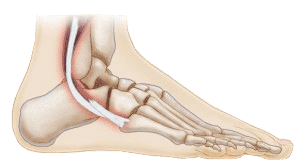What is Peroneal Tendonitis?
 Peroneal tendonitis occurs when the peroneal tendons become inflamed. This happens when there is an increased load and overuse of the tendons, leading to them rubbing on the bone causing irritation. Due to the friction, the tendons will swell and overtime thicken in size and try to manage with the increased load.
Peroneal tendonitis occurs when the peroneal tendons become inflamed. This happens when there is an increased load and overuse of the tendons, leading to them rubbing on the bone causing irritation. Due to the friction, the tendons will swell and overtime thicken in size and try to manage with the increased load.
This injury often occurs in a sport that involves repetitive ankle motion. These athletes are more likely to make their feet roll outwards, which causes friction between the tendon and bone.
It is common for someone to develop peroneal tendonitis if that person fails to complete rehabilitation after an ankle injury. The peroneal tendon will thicken over time as scar tissue attempts to repair the injured area. This makes the tendon weaker and more prone to future injury.
Peroneal Tendonitis Symptoms
Peroneal tendonitis can be either acute or chronic. Acute meaning that it comes on suddenly and chronic meaning that it slowly develops over time. Regardless, there are some common symptoms, as follows:
- Pain at the back of the ankle
- Pain when turning the foot in or out
- Swelling at the back of the ankle
- Pain that worsens during activity and lessons during rest
- The area is warm to the touch
- Instability of the ankle when bearing weight
Causes of Peroneal Tendonitis
It is common for people who participate in a sport that involves repetitive ankle movement to experience peroneal tendonitis. The most common causes are as follows:
- Contributors to the condition include:
- Improper training or a sudden increase in training, particularly weight-bearing activities
- Overuse
- Inadequate or unsupportive footwear
Peroneal Tendonitis Treatment
Before surgical treatments are considered, conservative options are explored. Rest is a very important role in healing for this injury.
Non-Surgical:
Medication: Anti-inflammatory drugs, such as ibuprofen can help relieve pain and swelling.
Immobilization: This device is meant to stop the movement of the foot/ankle using a boot for support
Physical Therapy: Start off with ice and heat. Once the symptoms have improved you can begin to strengthen the muscles and improve balance.
Bracing: Depending on how well you’ve healed, you might require a brace for use during activities that cause repetitive ankle movement.
Cortisone Injection: A cortisone injection might be offered as an anti-inflammatory.
Surgical:
Although rare, surgical options are available for this injury.
